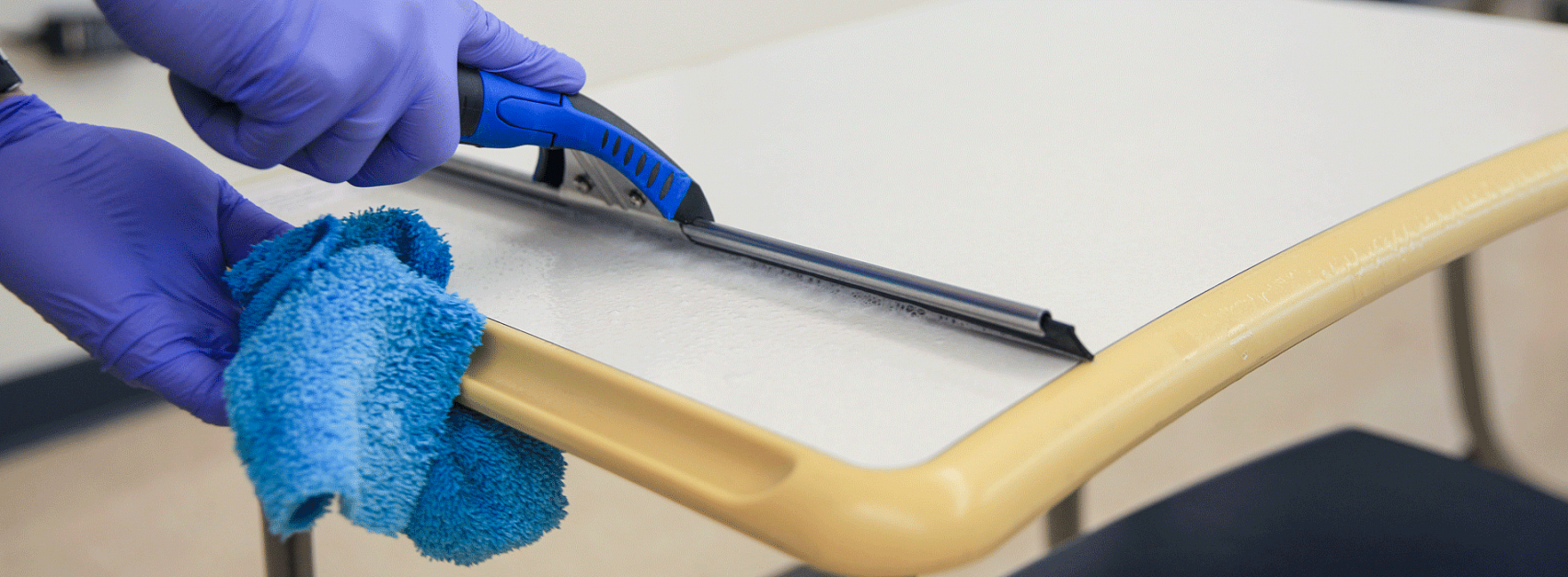Reducing Contamination on Desktop Surfaces
From head to toe, we are covered in microbes. Most of them are beneficial for our health, but some are not. Office environments, in particular, are places where unwanted germs can multiply and spread.
Office workers are constantly in direct contact with desks, office supplies, computers and other equipment. They touch dozens of surfaces in the space of an hour, spreading germs from one object to the next. As germs spread and illness grows, employees tend to call out, leading to workflow disruptions and reduced productivity. Surely, no employer enjoys scrambling to reassign projects or find reliable substitutes for their valuable staff. But thanks to our research-based cleaning routines, employers can avoid many of these problems.
“Humans were clearly the primary source of office bacterial contamination,” according to researchers Krissi Hewitt, Charles Gerba, Sheri Maxwell and Scott Kelley, who studied the presence of microbes in offices across three U.S. cities. “The most abundant of these genera tended to be common inhabitants of human skin, nasal, oral or intestinal cavities.”
In another study led by Jordan Peccia, professor of Chemical and Environmental Engineering at Yale University, researchers found an abundance of human cells, bacteria, viruses and fungi on desktop surfaces.
The study was conducted over four months during prime flu season at four different elementary schools in Connecticut where different cleaning techniques were put in place. Desktops in third and fifth-grade classrooms were cleaned with disinfectant spray and a microfiber towel three days per week, while desktops in fourth-grade classrooms were cleaned with disinfectant spray and a squeegee three days per week. The researchers monitored the desks weekly to measure the germ build-up on these surfaces.
Peccia and his team learned that a combination of disinfectant spray, microfiber fabric and squeegee cleaning is more effective than using a disinfectant spray and microfiber cloth alone. They also found that with frequent human contact, germs tend to reestablish themselves on desktop surfaces, pointing to the importance of regular cleaning. Bacteria reemerged within two days; fungi reappeared within three days.
Similarly, Charles Gerba, professor of Environmental Science at the University of Arizona, found that viruses can spread quickly from a frequently touched surface. In the span of two to four hours, a virus that first appeared on a tabletop could be found on 40 to 60 percent of employees and visitors in an office space, as well as on other commonly touched objects.
Thus, a desk that was cleaned early in the morning could become easily re-contaminated if, for example, a person carrying the flu virus touched the desk directly or coughed and sneezed in its vicinity.
Germs travel not only through contact, but also through the air. When a person coughs or sneezes, particles are released through the nose and mouth. Some of these are big enough to land and stick to nearby surfaces right away; others are too small to be pulled down by gravity immediately and can travel far distances in the air. Even a six-foot distance—recently touted as the safe zone for the coronavirus—is not always enough to protect a surface from airborne microbes. And once settled on flat surfaces, respiratory droplets can be re-suspended in the air, again heightening the risk of entering human bodies.
In the cleaned desk scenario mentioned earlier, even if a person were not ill, he or she could have tracked in the germs—having touched a previously soiled object, such as a railing or elevator button—and re-contaminated the clean surface. Of course, it is impossible to predict exactly when contamination events might occur, and this is why a regular cleaning schedule is so crucial in mitigating the constant onslaught of germs.
Without frequent cleaning, office buildings become hot zones for spreading germs. The ideal cleaning schedule depends on several factors, such as the building’s size and number of occupants. At Avery Cleaning, we are happy to work with you to determine the best cleaning plan for your office.
Our practices are deeply embedded in scientific research, and we use a spray-microfiber-squeegee extraction vacuum for all desktop surfaces. This approach helps reduce the cross-contamination of office objects, and ultimately, illness. For companies, that can go a long way in cutting employee absenteeism and boosting productivity. Call Avery Cleaning today at (860) 503-8333 for a free, customized quote.

